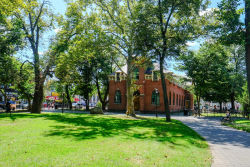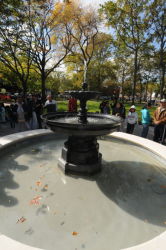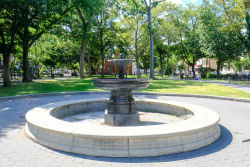Tappen Park
Stapleton Public Restroom
The neighborhood of Stapleton, founded in 1836, was named for William J. Staples (1807-1883), who along with his partner Minthorne Tompkins (1807-1881), purchased the land in the northeast corner of Staten Island from the Vanderbilt family. They decided to name their development Stapleton because Tompkins’s name had already been preserved in nearby Tompkinsville, named for his father, Daniel Tompkins (1774-1825), Governor of New York and the sixth Vice President of the United States.
German immigrants who settled here in the 1860s immediately recognized this area’s beer brewing potential. The many fresh springs would provide good water, and caves dug into the hillsides could be used for storing beer at cool temperatures. The first brewery to open was Bechtel, and several others soon followed, the largest of which was the Rubsam & Horrmann Atlantic Brewery. Several bottling companies flourished alongside the breweries, and by the 1870s Stapleton was the commercial center of Staten Island. Its well-to-do residents lived in grand houses along St. Paul’s Avenue, and its workers lived in the “workers’ cottages” downtown.
In 1898, upon the consolidation of the City of New York, Staten Island became a borough of the City. Ten years later, a municipal ferry service opened between Manhattan and Staten Island. Two boats, the Stapleton and the Castleton, ran between Whitehall in Manhattan and Canal Street in Stapleton. But during the 1920s this ferry service was abandoned in favor of an international marine terminal. A string of 17 piers was constructed, along with multistory enclosures and docks. Landfill was dumped in the water to create a 50-acre facility for trains and trucks. Unfortunately, the project cut Stapleton off from its waterfront, separating the town from its direct connection with the harbor. The natural beauty, though, of the hills, woods, animals, and trees remained.
This small parcel of land, on Wright Street between Water and Canal Streets, was assigned to Parks on July 23, 1964. The public restroom was intended to serve Tappen Park, across Wright Street. James J. Tappen (1891-1918) served in the Company D 308th Infantry Division during World War I. He was killed on September 29, 1918, at Binarville, France, during the Battle of Argonne. The park was named for Tappen in July 1934 by a bill signed by Mayor Fiorello H. LaGuardia (1882-1947). Prior to that time, the property was called Washington Square by laws dating from 1867, though local residents called it Stapleton Park for the surrounding neighborhood.
The architecture of this public restroom draws from the Romanesque and Gothic styles. It has arched windows, a red brick façade, and wrought iron lanterns flanking its entrance. The benches and streetlamps are designed in a similar style. Today, with Wright Street closed to traffic, Tappen Park and the Stapleton Public Restroom are contiguous.
Check out your park's Vital Signs
Clean & Safe
Green & Resilient
Empowered & Engaged Users
Share your feedback or learn more about how this park is part of a
Vital Park System










